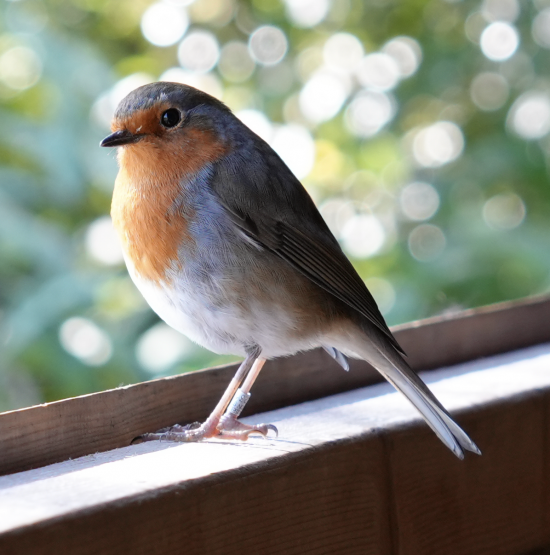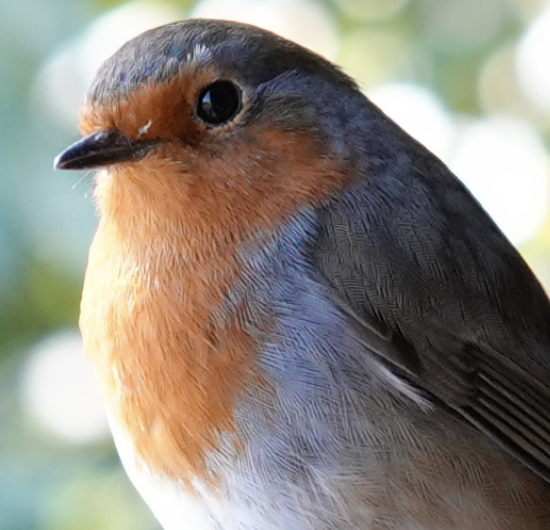I am working on ideas for several academic projects this week, some of which I am doing out of the office. A camera has travelled with me. This is early morning dew on a spider's web, magnified many times:

I was making notes in a bird hide, waiting for things to happen, and a robin joined me:

I enlarged the photo up to look at the detail:

There is no way I could have seen that even if the robin was only, maybe, two metres away.
And for the record, I was thinking about a chapter I am writing on risk and uncertainty for the Accounting Streams project. Sometimes these things progress best by taking them out to work on, especially with a robin for company.
Thanks for reading this post.
You can share this post on social media of your choice by clicking these icons:
There are links to this blog's glossary in the above post that explain technical terms used in it. Follow them for more explanations.
You can subscribe to this blog's daily email here.
And if you would like to support this blog you can, here:


 Buy me a coffee!
Buy me a coffee!

I always think that as at this time of the year as robins are more visible and are singing again, that it is part of a clever ploy to remind humans how friendly robins are and so putting out food for them is much appreciated! A robin that lived in the garden years ago would always perch on a nearby shrub and twitter away “Hi, its me, oh and winter is coming on so what about some food!”
I doubt food was this one’s whole motive, but it might have had luck there before I arrived
I did not oblige – largely as I had nothing to give it
The message my boy is detail – focus on the detail – sadly missing in our political economy and accounting since 1979.
Bring it back I say.
Hello again Richard. I notice your robin has been ringed… but I doubt you could enlarge the photo enough to read the tag!
Slightly off topic (but consistent with me often citing Scotland’s National Bard on your blog):- Robert Burns often refered to himself as Robin as in “Rantin’, Rovin’ Robin” (aka ‘There was a lad’ written in 1787).
Way, way off topic (Gisele Pelicot).
Link below is to contemporay Scots poet Len Pennie on the subject of our male complicity of silence when aware of domestic abuse.
https://www.youtube.com/watch?v=xeJX8Tl_id4
Most of Len’s work is spoken in Scots but the emotion evident in ‘My Brother’s Keeper’ results from her experience of being a ‘survivor’, “caught in a bad romance” as Lady Gaga would say.
See Richard… I don’t JUST read long-dead poets!
It’s also been ringed. I heard a bird expert say that “our” robins (in Scotland) move south over winter and other robins come across from Norway – presumably on longships to do a bit of pillage and rape.
That is correct
Robins do migrate
But not fur the reasons you give
To me Robins always seem to herald the coming of winter, when we tend to see them far more. Some years past, my husband and I were travelling on the Baltic coast of Sweden in April, when a “fall” of hundreds of Robins happened around us. It was amazing. Nature never disappoints.
Agreed
On Xmas Eve 1969 the BBC began a series called “The Private Life of…” with the Robin. I seem to remember it was regarded as quite an eye opener showing many aspects of the robin which many would never imagine. “ The robin is Britain’s most popular bird; it strikes up friendships with humans and nests in the unlikeliest places. At Christmas the redbreast on our greetings cards is a messenger of peace and goodwill, but in reality it can be a belligerent defender of its back-garden territory.” (BBC). Sadly it’s not available.
It often surprises some people who have little interaction with animals just how aggressive they can be to one another – and to humans too in some circumstances – but they don’t usually do each other serious harm. We had a couple of cows in the herd, normally placid creatures, who every so often would have a head-banging contest. One one occasion I got quite worried as one of them was heavy in calf and her rival was butting her full force in the side. I could only watch until they finished, as it was too dangerous to intervene. Fortunately no harm was done.
And some birds can be very aggressive towards humans at nesting time.
Robins fight to the death.
The alarm call is quite different to the usual cheery one.
It can be very interesting to watch bird behaviour.
I often spread good quality bird food (suet pellets, mealworms, etc) out on the ground in the winter time, when natural food is scarce. And watch. Blackbirds are the first to arrive every time, but they keep chasing each other away from the food …to the extent that none of them gets any! After a while, crows, magpies and woodpigeons turn up …and that’s the food away in a twinkle.
I find it interesting as well, that birds don’t generally chase away other birds of a different species—only their own! Magpies, crows and woodpigeons feed happily side by side. But let another pair of the same species turn up, and things get lively. So much for survival of the species, eh?
There is a lesson embedded in that somewhere, I’m sure!
Thing is, Jan, Bird Tables, feeders, fat balls etc are human interventions and so bird behaviour may not be typical of what would happen in the “wild”. Of course human intervention is so widespread that all, or much, animal behaviour may not be “natural” but has been modified by our presence.
That said, it is a delight and good for our wellbeing to see birds, and other wild creatures, visit our gardens. We and our neighbour have been blessed by a hare (or hares) in our gardens these past few weeks and last autumn we had a cheeky red squirrel pinch our hazel nuts. Now we have some little hazels sprouting in the lawn!
I am reminded by how animal behaviourists used to study animal behaviour by looking at animals kept in zoos, which was so far removed from how they behaved in the wild that anything they discovered was essentially worthless.
The Chicago Plan was raised by Mr Polito in a thread some time ago. The background is reviewed in an IMF Working Paper; Michael Kumhof and Jaromir Benes, ‘The Chicago Plan Revisited’ (2012), (https://www.imf.org/en/Publications/WP/Issues/2016/12/31/The-Chicago-Plan-Revisited-26178#:~:text=At%20the%20height%20of%20the,100%25%20reserve%20backing%20for%20deposits.).
The Abstract is here:
“At the height of the Great Depression a number of leading U.S. economists advanced a proposal for monetary reform that became known as the Chicago Plan. It envisaged the separation of the monetary and credit functions of the banking system, by requiring 100% reserve backing for deposits. Irving Fisher (1936) claimed the following advantages for this plan: (1) Much better control of a major source of business cycle fluctuations, sudden increases and contractions of bank credit and of the supply of bank-created money.
(2) Complete elimination of bank runs. (3) Dramatic reduction of the (net) public debt.
(4) Dramatic reduction of private debt, as money creation no longer requires simultaneous debt creation. We study these claims by embedding a comprehensive and carefully calibrated model of the banking system in a DSGE model of the U.S. economy. We find support for all four of Fisher’s claims. Furthermore, output gains approach 10 percent, and steady state inflation can drop to zero without posing problems for the conduct of monetary policy”.
The Chicago Plan Revisited is a 70 page paper. I have not had sufficient time to do it justice to comment. I am here circulating it for the information of readers of this Blog. The Conclusion (p.55-56) is set out below:
Conclusion:
This paper revisits the Chicago Plan, a proposal for fundamental monetary reform that was put forward by many leading U.S. economists at the height of the Great Depression. Fisher (1936), in his brilliant summary of the Chicago Plan, claimed that it had four major advantages, ranging from greater macroeconomic stability to much lower debt levels throughout the economy. In this paper we are able to rigorously evaluate his claims, by applying the recommendations of the Chicago Plan to a state-of-the-art monetary DSGE model that contains a fully microfounded and carefully calibrated model of the current U.S. financial system. The critical feature of this model is that the economy’s money supply is created by banks, through debt, rather than being created debt-free by the government.
Our analytical and simulation results fully validate Fisher’s (1936) claims. The Chicago Plan could significantly reduce business cycle volatility caused by rapid changes in banks’ attitudes towards credit risk, it would eliminate bank runs, and it would lead to an instantaneous and large reduction in the levels of both government and private debt. It would accomplish the latter by making government-issued money, which represents equity in the commonwealth rather than debt, the central liquid asset of the economy, while banks concentrate on their strength, the extension of credit to investment projects that require monitoring and risk management expertise. We find that the advantages of the Chicago Plan go even beyond those claimed by Fisher. One additional advantage is large steady state output gains due to the removal or reduction of multiple distortions, including interest rate risk spreads, distortionary taxes, and costly monitoring of macroeconomically unnecessary credit risks. Another advantage is the ability to drive steady state inflation to zero in an environment where liquidity traps do not exist, and where monetarism becomes feasible and desirable because the government does in fact control broad monetary aggregates. This ability to generate and live with zero steady state inflation is an important result, because it answers the somewhat confused claim of opponents of an exclusive government monopoly on money issuance, namely that such a monetary system would be highly inflationary. There is nothing in our theoretical framework to support this claim. And as discussed in Section II, there is very little in the monetary history of ancient societies and Western nations to support it either.
Counter intuitive, but maybe my intuition is misguided